
ГБПОУ «ДОНЕЦКИЙ ПРОМЫШЛЕННО-ЭНЕРГЕТИЧЕСКИЙ КОЛЛЕДЖ»
Цикловая комиссия филологических дисциплин
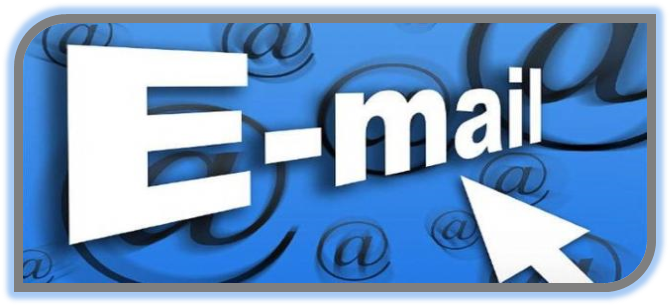
МЕТОДИЧЕСКАЯ РАЗРАБОТКА
открытого занятия
учебной дисциплины ОГСЭ.03 Иностранный язык
по теме « Электронная корреспонденция.
Употребление модальных глаголов Should, would».
2022
МИНИСТЕРСТВО ОБРАЗОВАНИЯ И НАУКИ ДОНЕЦКОЙ НАРОДНОЙ РЕСПУБЛИКИ
ГБПОУ «ДОНЕЦКИЙ ПРОМЫШЛЕННО-ЭНЕРГЕТИЧЕСКИЙ КОЛЛЕДЖ»
Цикловая комиссия филологических дисциплин
СОГЛАСОВАНО УТВЕРЖДАЮ
Зам. директора по УР ГБПОУ ДПЭК Директор ГБПОУ ДПЭК
__________ Е.В. Донченко ___________И.А. Караван
« » ____________2022г. « » _____________2022г.
МЕТОДИЧЕСКАЯ РАЗРАБОТКА
открытого занятия
учебной дисциплины ОГСЭ.03 Иностранный язык
по теме « Электронная корреспонденция.
Употребление модальных глаголов Should, would».
2022
Методическая разработка открытого занятия по теме «Электронная корреспонденция. Употребление модальных глаголов Should, would» составлена в соответствии с требованиями государственного образовательного стандарта специальности СПО ДНР 09.02.02 Компьютерные сети согласно учебного плана ОПОП специальности, рабочей программе учебной дисциплины ОГСЭ.03 Иностранный язык данной специальности.
Составитель - Локтева Наталья Викторовна, преподаватель иностранного языка (английский язык) ГБПОУ «Донецкий промышленно-энергетический колледж», специалист I квалификационной категории.
Рецензенты:
1.Дикунова О.В., преподаватель русского языка ГБПОУ «Донецкий промышленно-энергетический колледж», специалист высшей квалификационной категории .
2.Голубничая Е.И., преподаватель иностранного языка ГБПОУ «Донецкий промышленно-энергетический колледж», специалист высшей квалификационной категории.
В данной методической разработке приведена методика проведения практического занятия усвоение новых знаний, применение знаний и формирование умений с элементами игровой технологии, проектного обучения. Использование современных педагогических технологий, которое положено в основу разработанного занятия, способствует созданию устойчивой мотивации студентов к изучению иностранного языка, активизирует творческую, познавательную и аналитическую деятельность обучающихся.
Методическая разработка может быть использована преподавателями иностранного языка образовательных учреждений среднего профессионального образования, а также студентами, осваивающими программу подготовки специалистов среднего звена.
Одобрена и рекомендована
с целью практического применения
на заседании
цикловой комиссии филологических дисциплин
протокол № от «»__________2022 г.
председатель ЦК_______________ Н.В. Локтева
Рецензия
на методическую разработку открытого занятия
учебной дисциплины ОГСЭ.03 Иностранный язык
по теме: «Электронная корреспонденция. Употребление модальных глаголов Should, would»
преподавателя Локтевой Натальи Викторовны
Методическая разработка составлена для проведения открытого занятия по английскому языку профессиональной направленности на II курсе обучения в соответствии с ОПОП, учебным планом специальности 09.02.02 Компьютерные сети, рабочей программе дисциплины Иностранный язык ОГСЭ .03 Иностранный язык.
В методической разработке указаны цели занятия, определены междисциплинарные связи. Кроме того преподаватель делает акцент на развитие творческих способностей студентов.
Преподаватель использует различные формы и методы актуализации опорных знаний студентов, такие как мозговой штурм, метод нарезок(cut-up method), метод догадки, методический прием « облако слов».
Занятие предполагает использование мультимедиа-системы, что способствует увеличению мотивации обучающихся к изучению иностранного языка.
На протяжении всего занятия студентам предлагается выполнить большое количество разно-уровневых заданий, направленных на развитие речевой компетенции обучающихся.
Методы и приемы, используемые на занятии, имеют интерактивный характер и направлены на развитие познавательных и творческих способностей студентов.
Представленная на рецензию методразработка выполнена согласно требований к составлению методических материалов по иностранному языку,
Данная методическая разработка заслуживает позитивной оценки и может быть рекомендована к использованию преподавателями образовательных учреждений среднего профессионального образования.
РЕЦЕНЗЕНТ:______________________________________________________
(Ф.И.О., должность, личная подпись)
__________________________________________________________________
Подпись заверяю_________________ ______________________________
(Ф.И.О., должность работника ОК)
__________________________________________________________________
М.П.
Рецензия
на методическую разработку открытого занятия
учебной дисциплины ОГСЭ.03 Иностранный язык
по теме: «Электронная корреспонденция. Употребление модальных глаголов Should, would»
преподавателя Локтевой Натальи Викторовны
Материал, представленный в методической разработке занятия изложен рационально, доступно, многогранно, логично.
Тема актуальна, направлена на развитие активного владения иностранным языком при работе с текстами по специальности.
В методической разработке определены цели и задачи практического занятия,
междисциплинарные связи.
Методическая разработка занятия предполагает активное использование мультимедийной системы. Методы и приемы , технологии, используемые на занятии, способствуют развитию коммуникативной, информационной, социальной компетенций студентов .
Методразработка составлена согласно требований к методическим документам такого типа.
Заслуживает позитивной оценки и может быть рекомендована к использованию при обучении иностранному языку обучающихся образовательных учреждений среднего профессионального образования.
РЕЦЕНЗЕНТ:_____________________________________________________
(Ф.И.О., должность, личная подпись)
_________________________________________________________________
Подпись заверяю_______________ ______________________________
(Ф.И.О., должность работника ОК)
_________________________________________________________________
М.П.
ВВЕДЕНИЕ
Методическая разработка практического занятия по теме «Электронная корреспонденция. Употребление модальных глаголов Should, would» специальность 09.02.02 Компьютерные сети ОГСЭ .03 Иностранный язык, подготовлена в соответствии с учебной программой Государственного образовательного стандарта Министерства образования и науки среднего профессионального образования Донецкой Народной Республики.
Процессы межкультурной интеграции обуславливают модернизацию содержания обучения иностранному языку. Существенно изменяется социокультурный контекст изучения иностранных языков. Знание иностранного языка сегодня является неотъемлемой составляющей образованного человека. Приблизить словарный запас и навыки устной речи к живому общению – одна из важнейших задач. Нужно формировать и развивать языковую, речевую и социокультурную компетенцию обучающихся, культуру устной и письменной речи; способствовать развитию умений творческого подхода к решению проблемных задач; воспитывать положительный интерес к изучаемому предмету.
Обучение студентов техникума иностранному языку является одним из приоритетных направлений и осуществляется с применением новых технологий обучения, с использованием ТСО, интерактивных форм и методов обучения. Использование игровых технологий и их элементов на занятии активизирует процесс обучения, делает его более интересным и мотивированным, так как происходит условное воспроизведение настоящей практической деятельности людей.
Предложенная методическая разработка – это один из вариантов организации и проведения практического занятия усвоение новых знаний, применение знаний и формирование умений с элементами игровой технологии и проектного метода обучения. Методическая разработка содержит учебный материал, имеющий коммуникативную направленность. Ожидаемые результаты: формирование познавательных интересов студентов, содействие сознательному усвоению иностранного языка, развитие самостоятельности, инициативности, повышение мотивации к изучению иностранного языка.
Содержание
Дата Группа КС Курс 2
Специальность 09.02.02 Компьютерные сети
Дисциплина ОГСЭ.03 Иностранный язык( английский язык)
Преподаватель Локтева Наталья Викторовна
Тема «Электронная корреспонденция.Употребление
модальных глаголов Should,would».
Цели:
|
методическая |
использовать методику проведения практического занятия с внедрением элементов мультимедийных технологий в процесс подготовки специалистов с целью формирования навыков активной самостоятельной работы и приобретения обучающимися индивидуального опыта учебно-познавательной деятельности; показать целесообразность применения интерактивных методов обучения при систематизации знаний по дисцип- лине «Иностранный язык»; продемонстрировать возможности использования группо- вых форм обучения для активизации умственной деятель- ности обучающихся; |
|
дидактическая |
отработать коммуникативные навыки, приобретенные знания на практике; развивать умения обучающихся анализировать поставлен- ные проблемы, систематизировать полученную информа- цию, делать выводы; совершенствовать навыки монологической и диалогичес- кой речи; привлекать обучающихся к творческой деятельности; совершенствовать навыки использования формальных оборотов речи и практики соблюдения речевого этикета в электронных письмах; сформировать у обучающихся представление об электрон- ной почте и других сервисах сетей, как средствах коммуникации в современном обществе, о возможностях функционирования этих услуг; научить студентов обосновывать свои мысли, отправлять, получать сообщения и прикрепленные файлы по электронной почте. |
|
развивающая |
развивать у обучающихся языковую реакцию и оператив- ную память, творческие способности; способствовать развитию самостоятельной познавательной ной деятельности обучающихся; развивать логическое, креативное мышление обучения; формировать потребность в знаниях и стремление к их постоянному обновлению; развивать умение самостоятельно анализировать учебный материал, наблюдательность и остроумие; формировать умение работать в группе и самостоятельно; развитие интереса обучающихся к изучению иностранного языка; |
|
воспитательная |
готовить обучающихся к активному, сознательному участию в процессе жизнедеятельности социума; способствовать расширению кругозора обучающихся; формировать устойчивый интерес к изучению английско- го языка; формировать информационную культуру обучающихся, привычку организовывать работу в соответствии с правилами этикета при написании писем электронной почты. |
|
Вид занятия |
практическое занятие |
|
Тип занятия |
усвоение новых знаний, применение знаний и формирование умений |
|
Методы: |
проблемно-поисковый; наглядно-демонстрационный (интерактивный), проектный |
|
Формы: |
индивидуальная, коллективно-групповая, беседа |
|
Междисциплинарные связи: |
|
|
обеспечивающие |
английский язык, экономика, информатика, русский язык. |
|
обеспечиваемые |
английский язык профессиональной направленности |
|
Методическое обеспечение занятия |
рабочая программа дисциплины, методическая разработка открытого занятия, задания для самоконтроля (проверка домашнего задания), информационно-компьютерное сопровождение занятия (презентации), задания для проверки усвоенных знаний, правила «Как правильно писать электронное письмо » (для домашнего задания); рекомендации по структуре написания электронного письма(для домашнего задания); |
|
Наглядность: |
раздаточный материал, правила: «Как правильно писать электронное письмо», грамматические таблицы. |
|
ТСО: |
мультимедийное проекционное оборудование, ноутбук. |
Литература:
основная
Бонк Н.А. Английский для международного сотрудничества. Издание СП «Прин Ди», 1992.-380с.
Дудорова Э.С. Практический курс разговорного английского языка: учебное пособие/.- «Издательство Союз» - С.-Петербург, 2001.- 341с.
дополнительная
Радовель В.А. Английский язык: основы компьютерной грамотности: учебное пособие/ Радовель В.А.- Изд. 11-е – Ростов н/Д : Феникс, 2012.- 219с.
Ионина И., Саакян А. Английская грамматика. Теория и практика. – М.: Академия, 2008
Мюллер В.К. Англо-русский и русско-английский словарь. – М.: ЭКСМО, 2010
Интернет-ресурсы
http://www.tagxedo.com
http://www.woculus.com
http://keepcalmandteachenglish.blogspot.com
http://www.english-online
https://ru.wikipedia.org/wiki
https://studfiles.net
Технологическая карта
по дисциплине ОГСЭ.03 Иностранный язык(английский)
специальность 09.02.02 Компьютерные сети
|
Группа, дата |
Группа КС |
||
|
Тема занятия |
Электронная корреспонденция. Употребление модальных глаголов Should, would. |
||
|
Цель занятия |
использовать методику проведения практического занятия усвоение новых знаний, применение знаний и формирование умений с применением проектного метода, метода проблемного обучения с применением игровых элементов. |
||
|
Задачи занятия |
Дидактические обеспечить в ходе занятия усвоение новой лексики; научить оперировать усвоенным лексическим материалом с опорой на коммуникативные инструкции, заданные преподавателем; формировать и совершенствовать навыки чтения и перевода, аудирования и говорения (диалогическая и монологическая речь) на основе изученной лексики; формировать умения выбирать и использовать речевые формы для осуществления коммуникативных намерений в конкретной ситуации; систематизировать и обобщить знания о модальных глаголах и лексико-грамматических структурах, в которых они используются.
|
Развивающие способствовать развитию умений творческого подхода к решению практических проблемных задач; развивать умение обобщать полученные знания и самостоятельно планировать речевой поступок; развивать умение грамотно, четко и точно выражать свои коммуникативные намерения; способствовать развитию логического мышления. |
Воспитательные воспитывать творческую активность, способность работать самостоятельно, в группах; воспитывать положительный интерес к изучению английского языка; готовить обучающихся к активному, сознательному участию в процессе жизнедеятельности социума; формировать информационную культуру обучающихся, привычку организовывать работу в соответствии с правилами этикета при написании электронной почты. |
|
Средства обучения, оборудование
|
раздаточный материал(задания для актуализации опорных знаний,) для проверки домашнего задания; грамматические таблицы; информационно-компьютерное сопровождение занятия (презентации), рекомендации по структуре и правилам написания электронного письма; мультимедийный проектор, экран, ноутбук, колонка. |
|
Тип занятия |
усвоение новых знаний, применение знаний и формирование умений |
|
Вид занятия |
практическое занятие |
|
Методы обучения
|
проблемно-поисковый; наглядно-демонстрационный(интерактивный); проектный. |
|
Междисциплинарные связи
|
английский язык, экономика, информатика, русский язык.
|
Структура занятия
|
1. |
|
Организационная часть |
2 мин |
|
1.1. |
Взаимное приветствие преподавателя и студентов. |
|
|
|
1.2. |
Проверка присутствия студентов и их готовности к занятию. |
|
|
|
2. |
|
Представление темы, целей и задач занятия |
3 мин |
|
3. |
|
Мотивация учебной деятельности В современном обществе все более возрастает роль иностранных языков. Знание иностранного языка дает возможность приобщиться к мировой культуре, использовать в своей деятельности потенциал обширных ресурсов глобальной сети Интернет, а также работать с информационными и коммуникационными технологиями и мультимедийными средствами обучения. Обучение студентов техникума иностранному языку является одним из приоритетных направлений и осуществляется с применением новых технологий обучения, с использованием современных интерактивных форм и методов обучения, направленных на развитие коммуникативных и познавательных компетенций обучающихся и повышение мотивации к изучению иностранного языка. Актуальность темы «Электронная корреспонденция» обусловлена потребностями современного общества. Сегодня информационные и интернет-технологии проникли во все сферы жизни и деятельности общества. Электронная почта обладает многочисленными достоинствами и является одним из наиболее широко используемых видов сервиса, как в корпоративных сетях, так и в Интернете. Роль электронной почты - очевидна. Она является не просто способом доставки сообщений, а важнейшим средством коммуникации, распределения информации и управления различными процессами в бизнесе, образовании, повседневной жизни. Благодаря этому виду сервиса решается одна из важнейших в настоящий момент задач - формирование единого информационного пространства. |
2 мин |
|
4. |
|
Актуализация опорных знаний студентов и контроль исходного уровня знаний. |
6 мин |
|
4.1. |
Составление ассоциативного ряда What is information today? |
1 мин |
|
|
4.2.
|
Работа в мини-группах (проверка подготовки студентов к практическому занятию). Определение 10 причин для написания деловых писем. |
1 мин |
|
|
4.3.
|
Составление из предложенных слов предложений при помощи метода нарезок. (Приложение1). |
2 мин |
|
|
|
4.4. |
Расположение в правильном порядке представленных частей неофициального письма, с учетом правил написания и структуры неофициальной корреспонденции. (Приложение 2). |
2 мин |
|
5. |
|
Основная часть. Тема: «Электронная корреспонденция. Употребление модальных глаголов Should,would». Изложение и изучение нового материала. |
27 мин |
|
5.1. |
Вступительная беседа. |
1 мин |
|
|
5.2. |
Чтение текста и ответы на поставленные вопросы.(Приложение3). |
5 мин |
|
|
5.3. |
Изучение новых слов по теме при помощи метода преобразования текста «облако слов».(Приложение 4,5) |
2 мин |
|
|
5.4. |
Дополнение предложений недостающими по смыслу словами.(Приложение 6). |
2 мин |
|
|
5.5. |
Презентация и доклады студентов. Представление видео презентации студентов ”Из истории электронной почты”. |
2 мин |
|
|
5.6.
|
Изучение 12 правил эффективного написания электронного письма.(Приложение7). Изучение структуры электронного письма.(Приложение8). Ответы студентов на поставленные вопросы.
Ознакомление студентов с символами написания и озвучивания электронного адреса.(Приложение9). |
3 мин
3 мин
2 мин
|
|
|
5.7. |
Определение преимуществ и недостатков электронной почты.(Приложение 10). |
3 мин |
|
|
|
|
|
|
|
|
5.8 |
Доклад студента на тему «Что такое этикет электронного письма».
|
2 ми
|
|
5.9. |
Видеопрезентация на тему «Что такое этикет электронного письма». |
2 мин
|
|
|
6. |
|
Актуализация грамматики. |
4 мин |
|
6.1. |
Выполнение грамматических заданий. |
4 мин |
|
|
7. |
|
Закрепление знаний студентов |
20 мин |
|
7.1.
|
Ответы студентов на поставленные вопросы.
|
3 мин
|
|
|
7.2. |
Работа в мини-группах. |
2 мин |
|
|
7.3. |
Выполнение лексических упражнений. |
8 мин |
|
|
7.4. |
Аудирование. |
7 мин
|
|
|
8. |
|
Подведение итогов занятия. |
10 мин |
|
9. |
|
Рефлексия. |
2 мин |
|
10. |
|
Домашнее задание. |
4 мин |
Ход занятия
1. Организационная часть:
1.1. Готовность к занятию: наличие методической разработки, плана занятия, иллюстративного материала и текстов для отработки.
1.2. Проверка присутствия студентов и их готовности к занятию:
T: Good morning, dear students and guests!
S: Good morning, teacher
T: I am glad to see you again. You may sit down. How are you today?
S: Fine, thank you.
T: What day is it today?
S: Today is …
T: Is everybody present?
S: All are present.
T: Are you ready for the class? Let’s begin it.
2. Представление темы, целей и задач занятия:
T: I hope that our guests will be interested in the subject of our today’s discussion. At our previous lesson we spoke about the ways of writing formal and informal letters and today we’ll find out how we should write electronic letters. I am sure it will help you in your future career.
2.1 Обзор
Teacher: Knowledge on this topic is necessary for students for broadening of their outlook, for the completion and deepening of active lexical vocabulary, for the development of interesting for studying English, for the demonstration of students’ intellectual and language capabilities.
2.2. Цели:
Today you are welcome to take part in the lesson on the topic «E-mail correspondence». The aim of our lesson is to learn the structure of emails and parts of an e-mail address like username, and domain; we’ll learn about netiquette, and how to safe communicate through e-mail; you’ll get aсquainted with rules of writing emails professionally and effectively.We’ll continue to develop our lexical skills, communicative abilities, our memory, speech and attention. We’ll listen to each other and we’ll develop our culture of communication skills.
3. Мотивация учебной деятельности студентов:
If you fall asleep now, you will dream. If you study now, you will live your dream.
T: Serious changes that took place in the world as in the sphere of foreign economic relations as in the field of culture, trade and economic development cause a high interest to learning foreign languages, especially English.
Email is one of the most widely used forms of professional communication between nations in the twenty-first century. That is why it is very important to know the rules of writing emails, the structure and the netiquette of email. Nowadays there’s no getting away from emails, especially in business. Emails are one of the most widely used forms of communication, taking over from older, slower methods of conveying messages like sending a fax or writing a letter. Email is highly effective, it only needs an internet connection to work and messages are easily archived and searched through, making it a popular tool for companies.
Is everything clear for you?
S1: Yes, this is a very interesting thing.
S2: It is very interesting to know the rules of emails because we are unaware of that.
4. Актуализация опорных знаний студентов и контроль исходного уровня знаний:
4.1. Составление ассоциативного ряда:
T: We live in the 21-st century, in the period of speed, rapid changes in politics, business and technology. Life is so unpredictable that we can’t imagine what other surprises it will give us. But in order to get in touch with all the changes we should possess information. What is information today? Give all possible associations with the word “information”. Comment your answers.
Ожидаемые ответы студентов:
S1: Information is knowledge, because learning information from many sources we are forming our luggage of knowledge.
S2: Especially for me information means independence, because if you have information you don’t depend on anyone and you can become a free man. Only free people can create their life.
S3: As for me information is opportunity. Because if you have information you can create something new that would make human life easier.
S4: I think information is the biggest power because a person who has information can rule the word. He can reach incredible heights owning information.
S5: Information is wealth because man owning important information owns the world.
S6: I think that information is a protection. The main thing is to use it correctly.
S7: As for me the information is the way to success. It’s a very important thing especially for those, who want to become more productive people. As somebody said: “ The one who owns information – owns the world”.
T: Who is able nowadays to get up-to-date information?
Ожидаемые ответы студентов:
S1: I think that everyone can get any information today as we use internet, newspapers, watch TV, communicate with different people.
S2: I don’t agree with this point of view. I think that only those people who can use personal computer and know foreign language are able nowadays to get up-to-date information.
T: I fully agree with you. Now look at the screen, please, and read the topic of our lesson. As you can see the topic of our lesson today is “Emails”. What do you think we shall discuss and talk about?
S3: I think we shall learn how to write emails correctly.
T: You are absolutely right.
4.2. Работа в мини-группах:
T: Divide into groups of 5-6 and make up a list of about 10 reasons of writing letters.
(Students work in small groups. They discuss the reasons of writing business letters and notes them in their workbook. The time of the work is limited – 3 min.)
Ожидаемые ответы студентов:
S1: Business letter is a main tool of business correspondence, which plays an important role in mutually beneficial and friendly relations with partners: customers, employees. A well-written business letter allows you to create a positive image of the organization. People usually write letters to request information, to express an opinion, to order something, to apply for a job or an education.
S2: People write letters because they contain a piece of their soul; a letter is an old tradition to share the warmth, love and attitude to someone or somebody; a letter is a way to express people’s own thoughts; in a letter you can express all your emotions.
S3: Letter is a means of exchange of information. It helps a person to engage in business and commercial activities. What is more, when you get a letter you have a lot of emotions.
T: Thank you . Your answers are very good.
4.3. Составление предложений при помощи метода нарезки.
And now I want you to make up two sentences from these pieces of paper with words according formal and informal letters and to stick them on the paper. I would like you to apply cut-up method technique. Pay attention: The cut-up technique is a literary technique in which a text is cut up and rearranged to create a new text. (Students work in small groups). (Appendix1)
4.4. Определение правильного порядка частей неофициального письма.
T: Very nice. Now write the following parts of the letter in the correct order.
(Appendix 2)
5. Изложение и изучение нового материала:
5.1. Вступительная беседа
T: What is an e-mail? E-mail is a short word for electronic mail. E-mail is information stored on a computer that is exchanged between two users over telecommunications. More plainly, e-mail is a message that may contain text, files, images, or other attachments through a network to a specified individual or group of individuals.
5.2. Чтение текста и ответы на поставленные вопросы:
T: Let’s read the text on E-mail and be ready to talk over the following questions. (Appendix3)
Questions:
1.What is electronic mail?
2. What kind of method is called electronic mail?
3. When did email first enter substantial use?
4. What are today’s email systems based on?
5.3. Изучение новых слов при помощи метода “Word cloud”.
T: I would like to show you a very interesting method of learning words.
This method is called a word cloud. A Word cloud is a visual representation of text data, typically used to depict tags on websites, or to visualize free form text. Look at the screen it’s an example of Word cloud.
Now you can see a Word cloud which we have made on the basis of the words according email (Appendix4)
Let’s find, read and translate the new words connected with email.(Appendix 5)
(Students find and read the words on the screen).
5.4. Дополнение предложений пропущенными по смыслу словами.
T: Make the following sentences complete.(Appendix 6)
1. Electronic mail, commonly referred to as email, is a method of……………………………………………….
2. Modern email operates across ………………………………………………………………………………
3. Some early email systems required that the author and the recipient both………………………………………………………………………………………………
3. Today neither the users nor their computers are required to be online ……………………………………………………………………………………………………….
4. Email gives the opportunity to exchange the information……………………………………………………………………………………..
5. Registration on different sites also requires …………………………………………………………………………………………..
5.5. Работа в мини-группах с использованием метода проектной технологии.
T: Now let’s watch the short video presentation of our student who investigated the topic “The history of email” and prepared detailed presentation. Be attentively and be ready to do some tasks.
The group is divided into 2 mini-groups. The first group, the task is to translate this video. The second group, the task is to answer the questions according this theme.
5.6. Изучение правил, структуры и символов написания электронного письма.
T: Business is serious. That’s why professional emails have rules. These rules will help you to avoid the common blunders of email communication. However, these rules are not set in stone. Take them as guiding principles for effective and professional email communication.
Look at the screen, you can see 12 Rules of Writing Emails professionally and effectively. You should write down them in your workbook.(Appendix 7)
(Students write down the rules of writing emails).
T: Now, let's get into the details of how to construct emails.
Look at the screen and pay attention to the structure of emails.(Appendix 8)
Answer the questions about the structure of the emails.
1. How many main parts does the email consist of?
Ожидаемый ответ студента:
S1: Email consists of three main parts.
T: What are they?
S2: They are: the Header and the Body, the Closing.
T: What does the Header of email include?
S3: The Header of email includes the following parts:
1) Subject
2) Sender (From:)
3) Date and time received (On)
4) Reply-to
5) Recipient (To:)
6) Recipient email address
7) Attachments
8) Signature
T: What does the Body of the email include?
Ожидаемый ответ студента:
S4: The Body of the email includes message to whom the email is typing.
T: What does the Closing of the email include?
Ожидаемый ответ студента:
S5: The closing of the email includes the complimentary close and the sender’s name.
T: What does the Signature of the email include ?
S6: The email signature should show the relevant contact details. Ensure this is in all the emails you send. Your relevant details are your full name, phone number (with country code), email address.
T: Look at the screen, please. Have you ever wondered what these symbols are called in English? Have you ever tried to read a website address and had no idea how to do it?
I would like you to say your own email address pay attention to the symbols related to computer technology.(Apptndix9).
(Students read and say their email addresses).
5.7. Определение преимуществ и недостатков электронной корреспонденции.
(Students work in small groups. They discuss the advantages and disadvantages of email
comment and type them in their workbook.)
T: Now I suggest you to look through the list of words which will help you to say about advantages and disadvantages of the emails. The first group should find out the advantages of the emails and the second one find out disadvantages of the emails.(Appendix10)
Ожидаемые ответы студентов:
Advantages of emails
S1: Emails are easy to use. You can organize your daily correspondence, send and receive electronic messages and save them on computers.
S2: Emails fast. They are delivered at once around the world. No other form of written communication is as fast as an email.
S3: The language used in emails is simple and informal.
S4: When you reply to an email you can attach the origin message so that when you answer the recipient knows what you are talking about. This is important if you get hundreds of emails a day.
S5: It is possible to send automated emails with a certain text.
S6: Emails do not use paper. They are friendly and save a lot of trees from being cut down.
S7: Emails can also have pictures in them. You can send birthday cards or newsletters as mails.
S8: Product can be advertised with emails. Companies can reach a lot of people and inform them in a short time.
Disadvantages of emails
S1: Emails may carry viruses. These are small programs that harm your computer system.
S2: Many people send unwanted emails to others. These are called spam mails.
S3: Emails cannot really be used for official business documents. They may be lost and cannot sign them.
S4: Your mailbox may get flooded with emails after a certain time so you have to empty it from time to time.
T: You are absolutely right. Thank you.
5.8. Сообщение студента на тему «Что такое этикет электронной почты».
T: And now let’s listen to the student who prepared the message about the Netiquette. It should be noticed that electronic correspondence has certain rules which are called the etiquette of the emails. And Pogrebnoy Artem will present them to us.
S1:"Netiquette" refers to Internet etiquette. This simply means the use of good manners in online communication such as e-mail, forums, blogs, and social networking sites to name a few. It is important to use netiquette because communication online is non-verbal. Most often online communication consists of reading something someone else has typed. This type of communication does not allow each person to see facial expressions, body language, or hear intonation. Because of this, messages can often be misinterpreted. By following netiquette, online communication becomes clearer. Especially in business and career related online communications netiquette should be used to ensure that correct spelling, grammar, and punctuation are put in place to project professionalism. Netiquette also includes the use of emoticons (such as :) :( ;) and others) to explain an emotion. In e-mail, netiquette means not flooding someone's inbox with forwarded messages or spam mail. Following netiquette will help you to maintain and establish positive online relationships as well as develop a positive online reputation.
5.9. Работа в мини-группах. Видеопрезентация на тему «Правила этикета электронной корреспонденции».
T: I suggest you to divide into groups of 5 and state the rules of netiquette.
6. Актуализация грамматики.
T: Now a little grammar. I suggest you to study the grammar structures with modal verb should. Look at the screen, please.(Appendix11).Should is used to give advice or make strong suggestions.
Студенты выполняют задания с модальными глаголами .(Appendix12).
7. Закрепление знаний студентов:
7.1 Ответы на вопросы:
T: Put the questions to the speakers.
Ожидаемые вопросы/ответы студентов:
S1: How to address to the recipient?
S2: It depends on how well you know the reader. If you know the recipient use Dear Mr James, and if you don’t know name the recipient use Dear Sir or Madam.
S3: Could you name the parts of the Header of the emails?
S4: There are:
1) Subject
2) Sender (From:)
3) Date and time received (On)
4) Reply-to
5) Recipient (To:)
6) Recipient email address
7) Attachments
S5: What does the body of the email include?
S6: The body of the email includes message to whom the email is typing.
S7: How shall we sign the email?
S8: The sign includes your full name, phone number (with country code), email address.
S9: Could you name the advantages of the emails?
S10: : Emails are easy to use, emails fast, emails do not use paper, emails can also have pictures in them.
S11: What is netiquette?
S12: Netiquette" refers to Internet etiquette. This simply means the use of good manners in online communication.
7.2. Работа в мини-группах:
T: Divide into groups of 3-4 and state 12 Rules of Writing Emails professionally and effectively.
(Students work in small groups. They discuss the basic rules of writing emails and type them in their workbook.)
Ожидаемые ответы студентов:
S1: Pay due attention to your grammar and spellings. Write on one topic at a time. Be SMART in your emails.
S2: Never ever write your emails in capital letters. Avoid using common abbreviations like IMHO, BTW etc. For effective contact, add voice to your text.
S3: Do not attach large files unless it is absolutely necessary. Avoid sending SPAMS. Always keep language professional.
S4: Always use paragraphs.
S5: Add a signature block at the end of the email to ensure the reader has details on how to contact you. Follow the Old AIDA (Attraction, Interest, Desire and Action) Writing Formula.
7.3. Индивидуальная работа студентов. Выполнение лексических упражнений:
T: Make your own sentences with the words:
Spam, Internet, electronic documents, message, business correspondence.
( Students work individually.)
T: Translate the following sentences:
1. Интернет стал частью современной жизни.
2. Почти все люди используют электронные сообщения.
3. Электронная корреспонденция имеет больше преимуществ, чем обычное письмо.
4. Компьютер выполняет миллионы задач.
5. Интернет помогает людям общаться.
6. Электронная почта может удаляться без прочтения.
7. В настоящее время уровень спама стремительно возрастает.
8. Электронная почта имеет свои недостатки.
7.4. Аудирование:
T: Let’s summarize everything said and listen to some additional information about email advantages and hezards from the native speaker. Listen and watch very attentively in order to name some facts about culture of writing the emails.(Students watch video).
8. Подведение итогов занятия:
T:Well, our lesson comes to its end I think you have learnt a lot of useful things about email. What have we learnt at the lesson? What adjectives can you use to characterize our lesson today? Let’s sum up our activity. We’ve learnt the rules and structure of the writing of emails, we have learnt how to read and say the symbols related to computer technology. We’ve found out the rules of netiquette and grammar constructions. I hope knowledge of a foreign language and skills to operate a computer, to use emails effectively and professionally will help you in your future life.
I’m pleased with your work. You were very attentive. The majority of students were active at doing tasks. You marks are…
9. Рефлексия.
Please, fill in this table. Do you like our lesson “Electronic correspondence”?
10. Домашнее задание.
T: Your hometask for the next lesson is to write an informal email. Pay attention to the rules and structure of writing emails. And you should do the grammar task.
Insert should or must
1. You………have studied the material thoroughly. I see you have made no mistakes in the test-paper.
2. You……... have studied the material thoroughly. Then you would not have made so many mistakes.
3. She……….have followed the doctor’s advice. She would have recovered by now.
4. She……….have followed the doctor’s advice. She looks very fine.
5. You………have ignored the instructions of your sport coach. That’s why you lost the game.
6. You……… have followed the instructions of your sport coach. Then you would have won the game.
This table will help you.
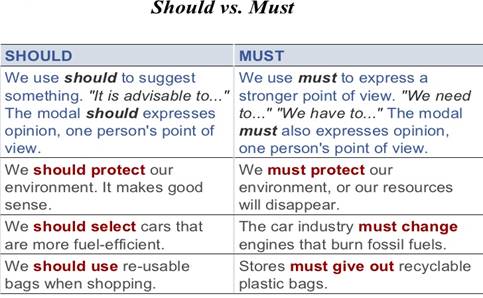
T: It’s time to finish. The lesson is over. Thank you. Have a nice day!
Appendix 1
15 October 2009
Mr James Hilton
General Manager
JMK Co Ltd
34 Wood Lane
London
Great Britain WC2 5TР
Dear James
2009 BUSINESS CONFERENCE, 10/11 DECEMBER 2009
I have pleasure in inviting you to attend our special conference to be held at Sheraton Hotel, London on Thursday/Friday 10/11 December 2009.
This intensive, practical conference for businessmen aims to:
· increase your business productivity
· enable networking with business partners
The seminar is power-packed with a distinguished panel of professional speakers who will give expert advice on many useful topics.
If you would like to join us please complete the enclosed registration form and return it to me before 30 August with your fee of ₤50 per person.
I look forward to seeing you again at this exciting conference.
Yours sincerely
John Smith
Conference Secretary
Appendix 2
Put the parts of the letter in the correct order
|
|
|||
|
|
|||
|
|
|
||
|
|
|
||
|
|
|
||
|
|
|||
|
|
|||
Appendix 3
Words:
instant message………………………..............................мгновенное сообщение
to exchange………………………………………………………….обмениваться
messages…………………………………………….............................сообщения
computer networks……………………………......................компьютерные сети
recipient…………………………………………………......................получатель
to forward………………………………………………………………пересылать
to deliver…………………………………………………......................доставлять
to store……………………………………………………….......................хранить
simultaneously………………………………………………………одновременно
to send…………………………………………………………………….посылать
to receive………………………………………………............................получать

Electronic mail (email or e-mail) is a method of exchanging messages between people using electronics. Email first entered substantial use in the 1960s and by the mid-1970s had taken the form now recognized as email. Email operates across computer networks, which today is primarily the Internet. Some early email systems required the author and the recipient to both be online at the same time, in common with instant messaging. Today's email systems are based on a store-and-forward model. Email servers accept, forward, deliver, and store messages. Neither the users nor their computers are required to be online simultaneously; they need to connect only briefly, typically to a mail server or a webmail interface, for as long as it takes to send or receive messages.
Appendix 4
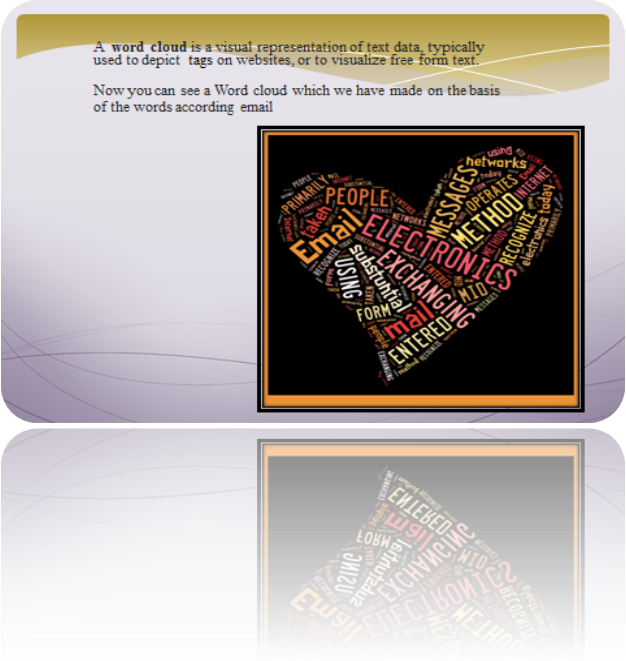
Appendix 5
Word cloud
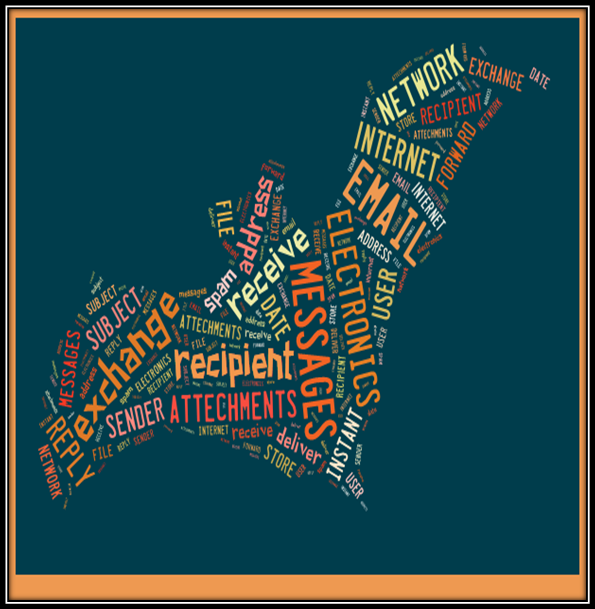
Appendix 6
Make the following sentences complete.
1. Electronic mail, commonly referred to as email, is a method of………………………………………………………………..
2. Modern email operates across ……………………………………………………………………………………………………..
3. Some early email systems required that the author and the recipient both………………………………………………………………………………………………
3. Today neither the users nor their computers are required to be online ………………………………………………………………………………………………………
4. Email gives the opportunity to exchange the information……………………………………………………………………………………..
5. Registration on different sites also requires …………………………………………………………………………………………..
Appendix 7
12 Rules of Writing Emails Professionally and Effectively
Business is serious. That’s why professional emails have rules. These rules will help you avoid the common blunders of email communication.
1. Pay Due Attention to Your Grammar and Spellings
Nothing makes an email uglier than bad grammar and wrong spellings.
2. Write on One Topic at a Time
Emails become boring when they are too long. A recipient is more likely to respond to your email if it is about just one issue and is straight to the point.
There is no harm in writing a follow-up email 3 or 4 days later, but let each email focus on one issue at a time, usually the most important issue.
3. Be SMART in Your Emails
Just like goals should be Specific, Measurable, Attainable, Realistic and Time-bound, professional emails should state the purpose , the required action and the timeline for the action.
4. Never ever write your emails in capital letters
What did you just notice?
I shouted at you, right?
That is not courteous enough for your clients. When you write your emails in capital letters, you shout at the reader.
5. Avoid using common abbreviations like IMHO, BTW etc
These abbreviations are better used for casual conversations with close friends. When you are making professional contacts, steer clear of them.
6. For Effective Contact, Add Voice to Your Text
Emails become much more effective when you contact your client on phone. After the call, they can check their emails for attached documents and to remind them of your discussion.
7. Do not attach large files unless it is absolutely necessary
Emails carrying large files are usually received in the spam box and may not be seen by clients. It is better to contact your client, and let the client know that you are about to send an email containing a large file.
8. Avoid sending SPAMS
Simply, do not send emails to people who may not be interested in you or you do not know.
9. Always keep language professional.
If necessary ask a friend or colleague to proof read before you send the email.
10. Always use paragraphs.
Ensure that the email is broken up into paragraphs and not written as
11. Add a signature block at the end of the email to ensure the reader has details on how to contact you.
NOTE: Add address and contact telephone number if necessary
12. Follow the Old AIDA (Attraction, Interest, Desire and Action) writing formula
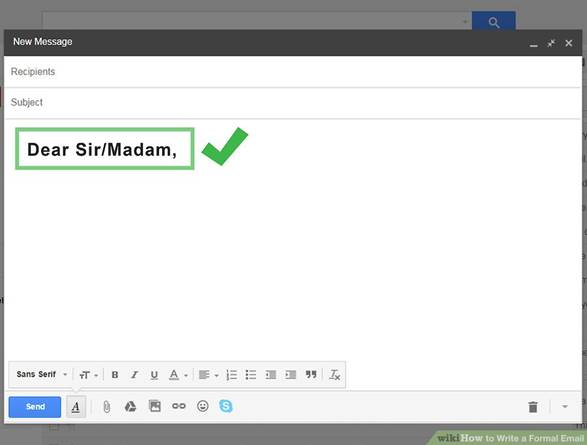
1
Use a proper salutation. Always open a formal email with a salutation. Addressing the recipient by name (if known) is preferred. Include the person's title (Mr., Mrs., Ms., Dr., etc.) with their last name, followed by a comma or a colon. You can precede the salutation with "Dear..." if you like.
· If you don't know the name of the person you're writing to, use a salutation like “Dear Sir/Madam,” “Dear Sir or Madam,” or “To whom it may concern.”
· Do not use “Hello,” “Hey,” “Hi,” or other informal salutations.
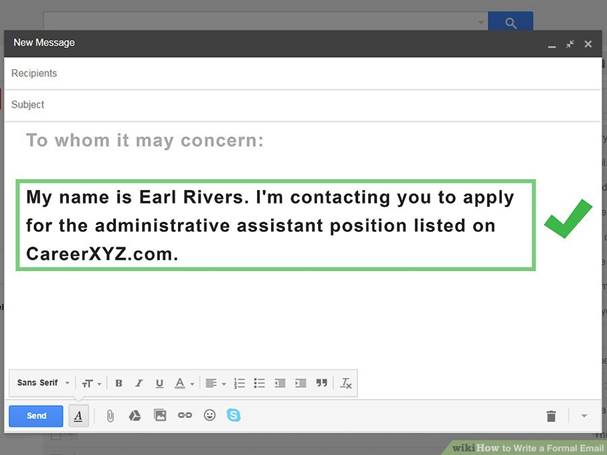
2
Introduce yourself in the first paragraph (if necessary). If you are writing to someone you don't have an existing relationship with, such as a new customer, hiring manager, or government official, tell them who you are and why you are writing. Do this in the first sentence or two of your email.
· For example, when writing to a potential employer, you might say: "My name is Earl Rivers. I'm contacting you to apply for the administrative assistant position listed on CareerXYZ.com."
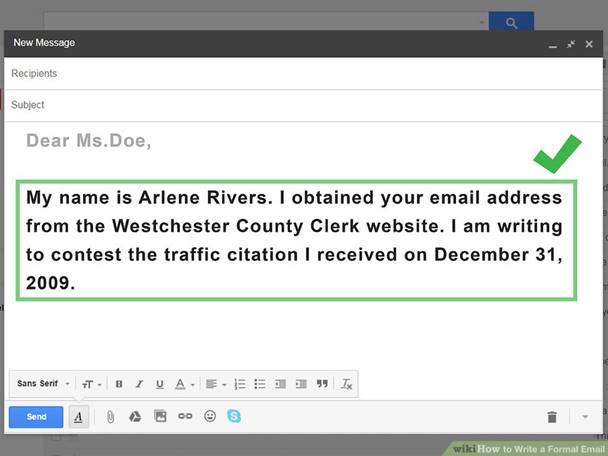
3
Prioritize the most important information. Once you’ve introduced yourself and the general reason you’re writing, you can follow up with the body of your email. Put the most important content near the top. This respects your recipient’s time, and makes the purpose of your email clear.[4]
When writing to a government official, for instance, you might start by saying: "My name is Arlene Rivers. I obtained your email address from the Westchester County Clerk website. I am writing to contest the traffic citation I received on December 31, 2009. "
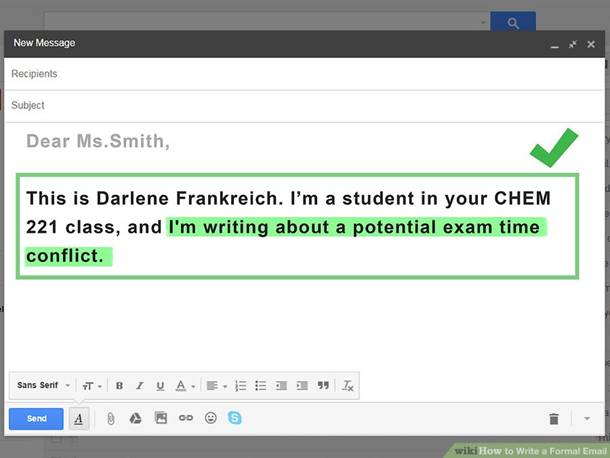
4
Get to the point. For a formal email, it’s ok to be direct, as long as you are polite. Beating around the bush will only lose your reader and make it harder to figure out what you want or need from them.[5]
· For instance, when writing to a professor, don’t waste space with unnecessary padding like: “This is Darlene Frankreich. Do you know me? CHEM 221 is my favorite class right now. I love the way the lectures are so organized. I can always follow along and know what will be on the tests. Speaking of tests, I was thinking about the next exam.”
· Instead, it would be much clearer to write something like: “This is Darlene Frankreich. I’m a student in your CHEM 221 class, and I'm writing about a potential exam time conflict.”
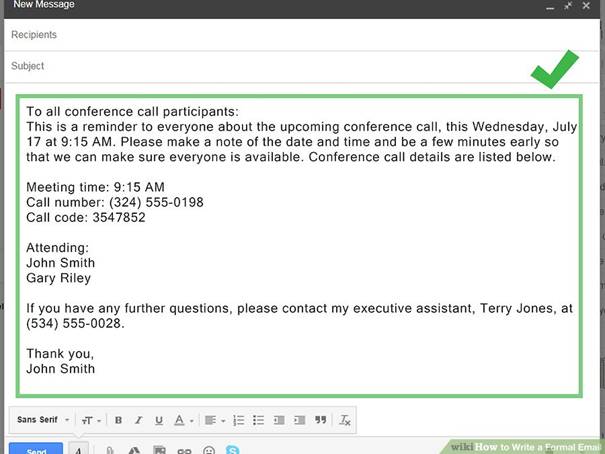
5
Keep it brief. There’s no set length for how long an email should be. However, it’s a good idea to keep an email to about one (laptop or desktop size) screen length.[6]
· If your email is relatively lengthy, break it up into short paragraphs. Insert a line break between each paragraph instead of indenting.
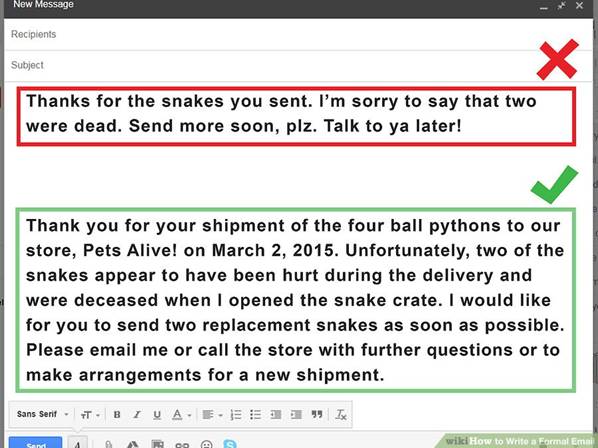
6
Use formal language. Since formal emails are written for professional contexts, you’ll want to give a good impression. Use complete sentences and polite phrasing. Avoid things like:[7]
· Slang
· Unnecessary contractions
· Emoticons and emojis
· Profanity
· Jokes
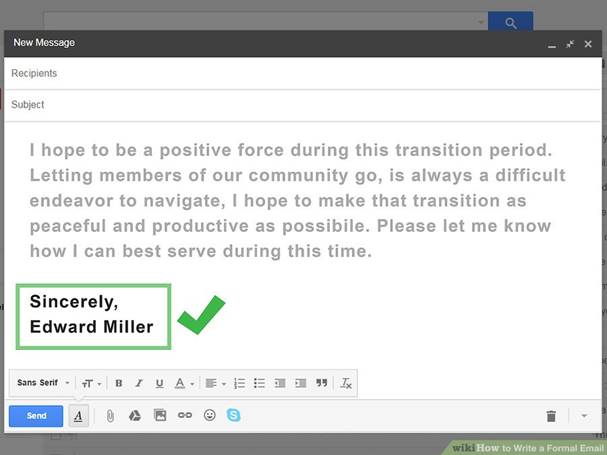
7
Use a proper form of closing. As with salutations, there are a variety of closings that are acceptable in formal emails. Make sure to follow up with your full name and job title or other signature (if you have one). Examples of potential closings include:[8]
· "Yours sincerely,"
· "Yours cordially,"
· "Respectfully,"
· "Best,"
· “Your student,”
Appendix 8
Structure of email
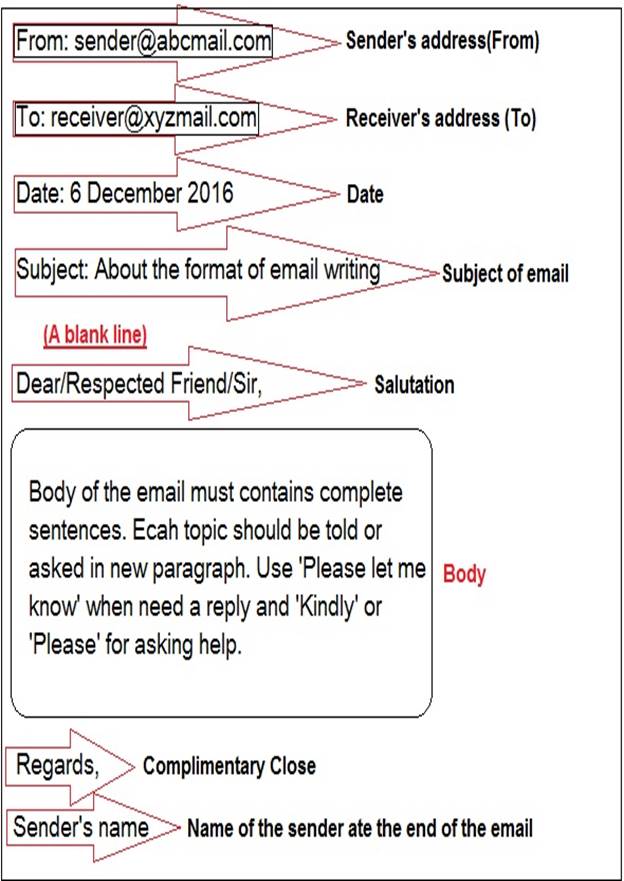
Appendix 9
Have you ever wondered what these symbols are called in English? Have you ever tried to read a website address and had no idea how to do it?
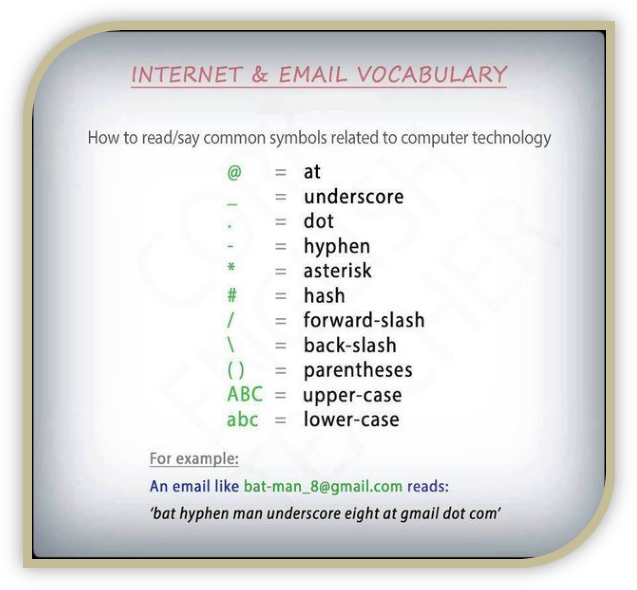
Appendix 10
EMAILS – ADVANTAGES AND DISADVANTAGES OF ELECTRONIC MAIL
Advantages of emails
Emails are easy to use. You can organize your daily correspondence, send and receive electronic messages and save them on computers.
· Emails are fast. They are delivered at once around the world. No other form of written communication is as fast as an email.
· The language used in emails is simple and informal.
· When you reply to an email you can attach the original message so that when you answer the recipient knows what you are talking about. This is important if you get hundreds of emails a day.
· It is possible to send automated emails with a certain text. In such a way it is possible to tell the sender that you are on vacation. These emails are called auto responders.
· Emails do not use paper. They are environment friendly and save a lot of trees from being cut down.
· Emails can also have pictures in them. You can send birthday cards or newsletters as emails.
· Products can be advertised with emails. Companies can reach a lot of people and inform them in a short time.
Disadvantages of emails
· Emails may carry viruses. These are small programs that harm your computer system. They can read out your email address book and send themselves to a number of people around the world.
· Many people send unwanted emails to others. These are called spam mails. It takes a lot of time to filter out the unwanted emails from those that are really important.
· Emails cannot really be used for official business documents. They may be lost and you cannot sign them.
· Your mailbox may get flooded with emails after a certain time so you have to empty it from time to time.
Appendix 11
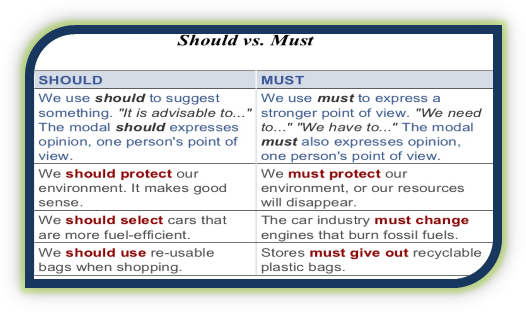
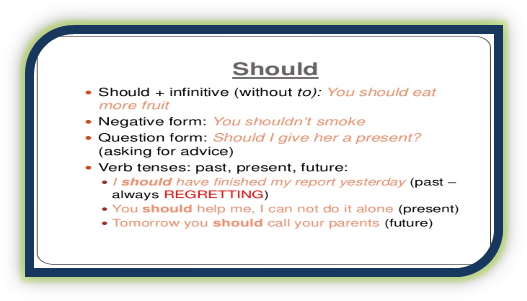
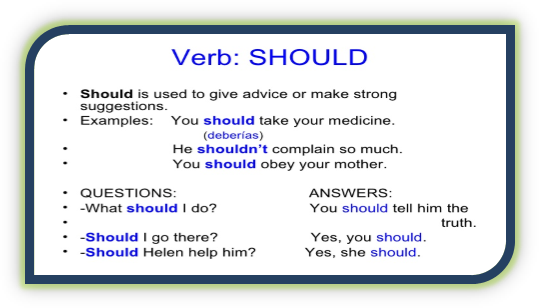
Appendix 12
Use the correct verb: must, have to or should:
1. I hadn’t enough money and I…pay by cheque.
2. You…see it. It’s the best film I’ve ever seen.
3. He…enter this room. It is dangerous.
4. English children…stay at school till the age of 16.
5. I think you…learn Spanish if you want to work there.
6. You…walk across the street on the crossing!
7. You…buy coffe in the cafeteria.
8. You… worry about it. It’s not important.
9. You…remember it to do your homework.
Insert should or shouldn’t
1. You … eat too much salt and sugar.
2. You … drive carefully.
3. It’s midnight. We … go home.
4. Your little daughter … spend so much money on toys.
5. It’s quite cold today. We … wear our jackets. 6. The service is awful here. We … complain to the manager. 7. Your shirt is dirty. You … change it.
8. The parcel is fragile. You … throw it.
Appendix 13
How do you like this lesson?
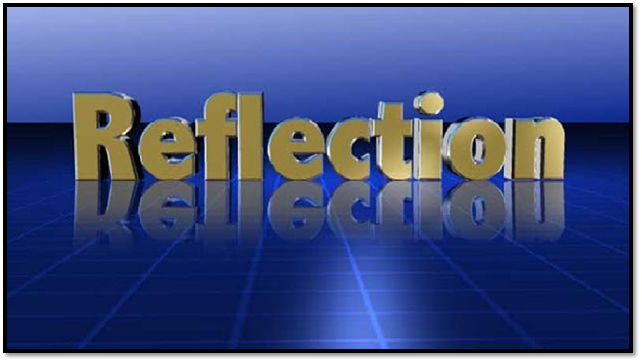
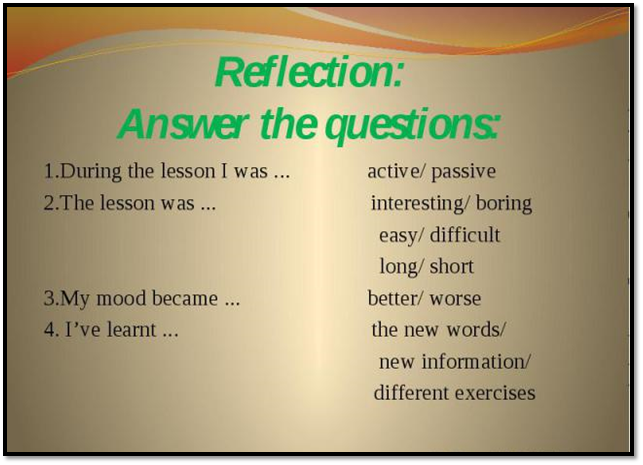
Appendix 14
Домашнее задание.
T: Your hometask for the next lesson is to write an informal email. Pay attention to the rules and structure of writing emails. And you should do the grammar task.
Insert should or must
1. You………have studied the material thoroughly. I see you have made no mistakes in the test-paper.
2. You……... have studied the material thoroughly. Then you would not have made so many mistakes.
3. She……….have followed the doctor’s advice. She would have recovered by now.
4. She……….have followed the doctor’s advice. She looks very fine.
5. You………have ignored the instructions of your sport coach. That’s why you lost the game.
6. You……… have followed the instructions of your sport coach. Then you would have won the game.
This table will help you.
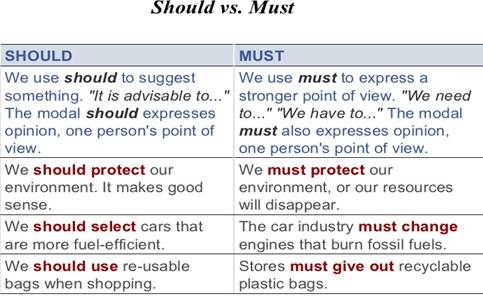
Скачано с www.znanio.ru
Материалы на данной страницы взяты из открытых источников либо размещены пользователем в соответствии с договором-офертой сайта. Вы можете сообщить о нарушении.